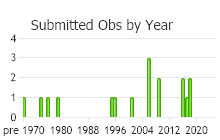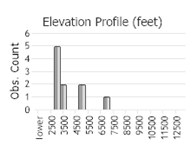View in other NatureServe Network Field Guides
NatureServe
Montana
Utah
Wyoming
Idaho
Wisconsin
British Columbia
South Carolina
Yukon
California
New York
Silvery Bryum Moss - Bryum argenteum
Other Names:
Silvergreen Bryum Moss
General Description
Plants: Loose to crowded tufts, silvery green to silver above, yellow or brown underneath (Flowers 1973). Stems 0.2-1 cm, reddish, appearing catkin- to bud-like from congested, appressed leaves, branched with innovations (Crum 1981). Acrocarpous.
Leaves: Similar moist or dry, slightly concave, appressed, crowded and overlapping, 0.3-1 (-1.2) mm in length, broadly ovate to ovate-lanceolate (FNA 2014). Apiculous short and recurved (Vitt 1988) to almost no apiculus. Apex acute to more broadly rounded, and distal ¼ to ½ of leaf usually hyaline (seldom all green). Margins flat or (rarely) slightly recurved proximally, not forming a border. Costa reddish near leaf insertion, vanishing before reaching apex (FNA 2014).
Leaf Cells: Basal cells subquadrate to short-rectangular, reddish. Distal cells rhomboidal (Crum 1981) to short- or elongate-hexagonal (FNA 2014), hyaline, with delicate pellucid walls, becoming more thickly-walled and yellow below (Crum 1981). (Plants lack chlorophyll in distal leaf cells, causing silvery appearance, Vitt 1988.)
Range Comments
Greenland; St. Pierre and Miquelon; Canada: AB, BC, MB, NB, NL, NT, NS, NU, ON, PE, QC, SK, YT; USA: AL, AK, AZ, AR, CA, CO, CT, DE, DC, FL, GA, ID, IL, IN, IA, KS, KY, LA, ME, MD, MA, MI, MN, MS, MO, MT, NE, NV, NH, NJ, NM, NY, NC, ND, OH, OK, OR, PA, RI, SC, SD, TN, TX, UT, VT, VA, WA, WV, WI, WY; Mexico; West Indies; Bermuda; Central America; South America; Eurasia; Africa; Indian Ocean Islands; Pacific Islands (New Zealand); Australia; Antarctica (FNA 2014). In Montana, known from Cascade, Deer Lodge, Fallon, Flathead, Gallatin, Lake, McCone, Missoula, Powell, Ravalli, and Rosebud Counties (Elliott 2016).
Observations in Montana Natural Heritage Program Database
Number of Observations: 18
(Click on the following maps and charts to see full sized version)
Map Help and Descriptions
Relative Density

Recency



 (Observations spanning multiple months or years are excluded from time charts)
(Observations spanning multiple months or years are excluded from time charts)
Habitat
Dry and open disturbed areas, such as paths, old fields, sidewalk crevices, railroad beds, sand and gravel, also on dry logs, stream banks, and sand dunes (Smith 2004). Possibly the most ubiquitous moss on Earth, but largely absent from its native undisturbed tropical habitat. Low to high elevations (0-13,000 feet) (FNA 2014).
Reproductive Characteristics
Dioicous. Setae 1-2 cm in length, brown to reddish-brown. Capsules 2-3 mm long, typically red (FNA 2014), rare in all habitats (Vitt 1988).
Asexual reproduction by bulbils in leaf axils (FNA 2014).
Management
Able to handle high levels of air pollution. Possibly nitrogen-loving as it is found on urine-infused soil such as around campsites and dog kennels (Crum 1981).
Stewardship Responsibility
References
- Literature Cited AboveLegend:
 View Online Publication
View Online Publication Crum, H.A. and L.E. Anderson. 1981. Mosses of Eastern North America. 2 volumes. Columbia University Press, New York. 1328 pp.
Crum, H.A. and L.E. Anderson. 1981. Mosses of Eastern North America. 2 volumes. Columbia University Press, New York. 1328 pp. Elliott, J.C. and A.K. Pipp. 2018. A Checklist of Montana Mosses (1880-2018). Updated 3 January, 2020. Montana Natural Heritage Program, Helena, Montana. 73 pp.
Elliott, J.C. and A.K. Pipp. 2018. A Checklist of Montana Mosses (1880-2018). Updated 3 January, 2020. Montana Natural Heritage Program, Helena, Montana. 73 pp. Flora of North America Editorial Committee, eds. 2014. Flora of North America North of Mexico. Volume 28. Bryophytes: Mosses, Part 2. Oxford University Press, Inc., NY. xxi + 702 pp.
Flora of North America Editorial Committee, eds. 2014. Flora of North America North of Mexico. Volume 28. Bryophytes: Mosses, Part 2. Oxford University Press, Inc., NY. xxi + 702 pp. Flowers, S. 1973. Mosses: Utah and the West. Brigham Young University, Provo, Utah. 567 p.
Flowers, S. 1973. Mosses: Utah and the West. Brigham Young University, Provo, Utah. 567 p. Smith, A.J.E. 1980. The Moss Flora of Britain and Ireland. Cambridge University Press, Cambridge. 705 pp.
Smith, A.J.E. 1980. The Moss Flora of Britain and Ireland. Cambridge University Press, Cambridge. 705 pp. Vitt, D. J. Marsh, and R. Bovey. 1988. Mosses, Lichens & Ferns of Northwest North America. Seattle, WA: University of Washington Press. 296 p.
Vitt, D. J. Marsh, and R. Bovey. 1988. Mosses, Lichens & Ferns of Northwest North America. Seattle, WA: University of Washington Press. 296 p.
- Additional ReferencesLegend:
 View Online Publication
View Online Publication
Do you know of a citation we're missing? Elliot, J. C. 1993. Second checklist of Montana mosses. Unpublished report. U.S. Forest Service, Region 1. Missoula, MT. 45 pp.
Elliot, J. C. 1993. Second checklist of Montana mosses. Unpublished report. U.S. Forest Service, Region 1. Missoula, MT. 45 pp. Lawton, E. 1971. Keys for the Identification of the Mosses on the Pacific Northwest. Reprinted from 'Moss Flora of the Pacific Northwest'. Published as Supplement No. 2 of the Journal of the Hattori Botanical Laboratory. Nichinan, Miyazaki, Japan. 66 pp.
Lawton, E. 1971. Keys for the Identification of the Mosses on the Pacific Northwest. Reprinted from 'Moss Flora of the Pacific Northwest'. Published as Supplement No. 2 of the Journal of the Hattori Botanical Laboratory. Nichinan, Miyazaki, Japan. 66 pp. Lawton, E. 1971. Moss Flora of the Pacific Northwest. Hattori Botanical Laboratory. Japan: Yamabuki-cho, Shinjuku-ku, Tokyo. 362 pages plus appendices.
Lawton, E. 1971. Moss Flora of the Pacific Northwest. Hattori Botanical Laboratory. Japan: Yamabuki-cho, Shinjuku-ku, Tokyo. 362 pages plus appendices.
- Web Search Engines for Articles on "Silvery Bryum Moss"





